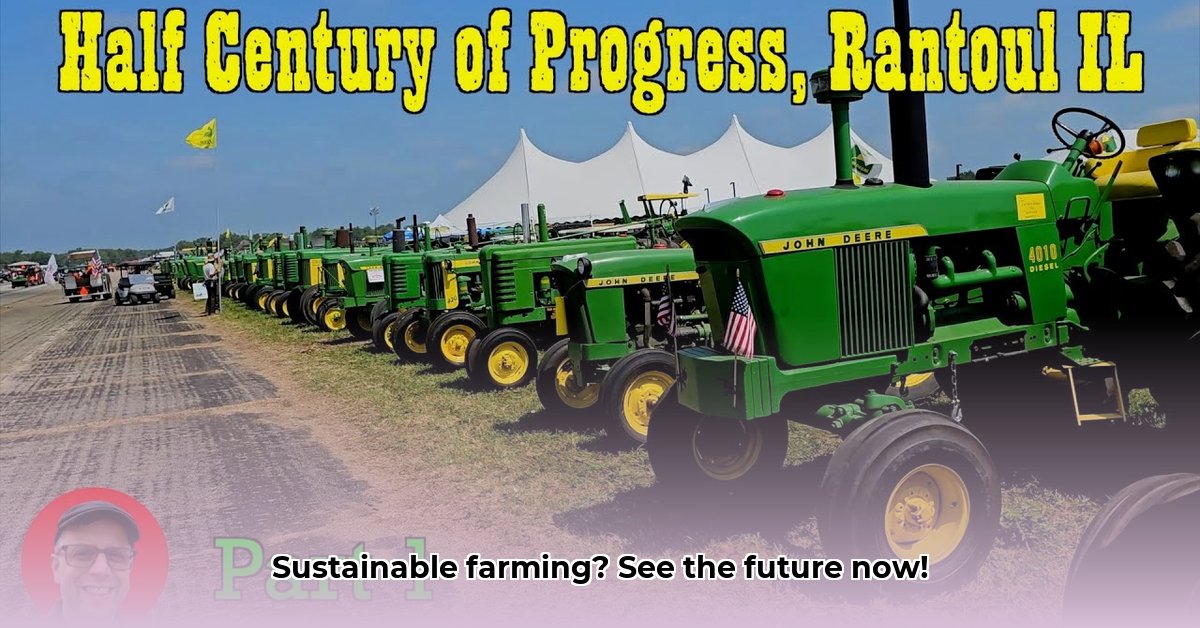
The roar of vintage engines, the scent of freshly turned earth, and a palpable sense of shared history – these are the hallmarks of the Rantoul, Illinois Tractor Show, also known as the Half-Century of Progress. More than just a gathering of gleaming metal, this annual spectacle offers a compelling lens through which to examine the past, present, and future of sustainable farming. With over 3,178 tractors on display in 2023 alone 1, the show's sheer scale is a testament to the enduring fascination with agricultural heritage and a potent starting point for a crucial conversation about the future of food production. But how can this nostalgic celebration inform the urgent need for environmentally responsible farming practices? For more on American-made tractors, check out this resource.
A Journey Through Time: Farming's Evolution and its Ecological Footprint
Imagine a time before GPS-guided tractors and precision agriculture. The Rantoul Tractor Show provides a vivid, hands-on journey through that era, showcasing the evolution of farm machinery from sturdy, early models to the sophisticated technology of today. This visual timeline raises a critical question: did increased efficiency always equate to environmental stewardship? The answer, as the show subtly reveals, is a resounding "no." Early farming practices, while undeniably ingenious for their time, often came at the cost of heavier fuel consumption, less efficient land use, and a heavy reliance on chemical fertilizers and pesticides. This historical context is crucial—how can we learn from these past practices to forge a more sustainable agricultural path? How can we reconcile the romanticism of older methods with the realities of their impact?
Isn't it intriguing how the very scale of the show—a testament to the deep-seated human connection to farming history—provides such a powerful opportunity to reflect on our past and future? The sheer volume of attending enthusiasts demonstrates a fundamental yearning for connection to agrarian roots. How, then, do we channel this passion toward building a future where productivity and environmental responsibility are not mutually exclusive?
Learning from the Past: Nostalgia and the Pursuit of Sustainability
This is where the Rantoul Tractor Show transcends mere nostalgia. It serves as a giant, open-air brainstorming session, prompting us to consider the design ingenuity of older tractors and how those principles might inspire more efficient and environmentally friendly models today. The show’s layout tacitly suggests the possibility that traditional practices, like crop rotation and integrated pest management, may hold valuable lessons for enhancing soil health and reducing our reliance on synthetic inputs.
However, a word of caution is warranted. Romanticizing the past without critical analysis is a dangerous path. The show's very existence highlights this tension – a compelling blend of appreciation for the past and a willingness to move forward. Can we identify the effective strategies from past generations and integrate them into the modern context? The answer, undoubtedly, is yes, but requires a balanced approach.
A Roadmap for Change: Actionable Steps Towards Sustainable Agriculture
The insights gleaned from the show translate directly into a practical plan for fostering sustainable farming practices. This framework combines short-term and long-term goals, empowering various stakeholders to contribute to a more eco-conscious agricultural future.
Short-Term Goals (0-1 year):
- Show Organizers: Partner with sustainable agriculture organizations to create educational materials highlighting the environmentally positive aspects of historical farming methods. (Efficacy: Increased visitor engagement and awareness, measured by post-show surveys and social media engagement.)
- Sustainable Ag Groups: Collaborate with the show organizers to showcase modern sustainable farming technologies and practices alongside the vintage equipment. (Efficacy: Measured by increased participation and interest in sustainable farming best practices.)
- Government Agencies: Explore funding opportunities to support the show's integration of sustainable agriculture into its programming. (Efficacy: Increased funding for sustainable initiatives directly tied to the show, measured by grant allocation and budget analysis.)
Long-Term Goals (3-5 years):
- Show Organizers: Incorporate educational workshops, demonstrations, and interactive exhibits focused on sustainable agriculture practices. (Efficacy: Measured by participant feedback and increased adoption of sustainable practices.)
- Sustainable Ag Groups: Conduct comparative research analyzing the efficiency and environmental impact of traditional and modern farming methods. (Efficacy: Measured by peer-reviewed publications and policy recommendations.)
- Government Agencies: Develop and implement policies that incentivize sustainable farming practices, learned from both historical successes and failures. (Efficacy: Measured by changes in farming practices and environmental outcomes.)
The Future of Farming: A Collaborative Endeavor
The Rantoul Tractor Show is not merely a static display; it's a dynamic conversation. It’s a conversation about the past, present, and sustainable future of our food systems. It’s a unique opportunity to learn from both our agricultural triumphs and the environmental consequences of less sustainable practices. This requires a collective effort, combining the enthusiasm for preserving agricultural heritage with a critical eye toward building a more environmentally responsible future for farming. How can we, as a community of farmers, researchers, and policymakers, use the fascination with agricultural history to cultivate a more sustainable food future? The potential of this unique platform is vast, and the future of responsible agriculture may well be written in the rich soil of the Rantoul Tractor Show's legacy.